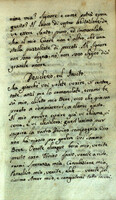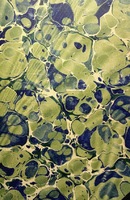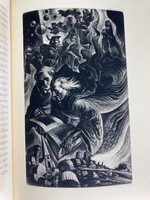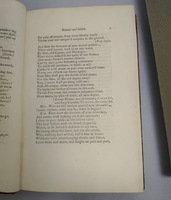Rare Books: A Glossary
Manicule — Ostrocon

Manicule: A term for the little hands drawn in the margins of many medieval and early modern books. The main feature of a manicule is its index finger, which is often cartoonishly long, and points at specific passages in the text. Most manicules were drawn by readers to note things but they were occasionally also added by printers. Each reader would draw a manicule in their own idiosyncratic way, sometimes lavishing great detail on anatomical detail and a sleeve cuff at the hand’s wrist and sometimes simply drawing a few quick round strokes to suggest other fingers.
Image: Eusebius, of Caesarea, Bishop of Caesarea, approximately 260-approximately 340. De evangelica praeparatione. Latin. Treviso: Michele Manzolo, 1480. BR65.E75 D448 1480
Manicule: A term for the little hands drawn in the margins of many medieval and early modern books. The main feature of a manicule is its index finger, which is often cartoonishly long, and points at specific passages in the text. Most manicules were drawn by readers to note things but they were occasionally also added by printers. Each reader would draw a manicule in their own idiosyncratic way, sometimes lavishing great detail on anatomical detail and a sleeve cuff at the hand’s wrist and sometimes simply drawing a few quick round strokes to suggest other fingers.

Manuscript: A document written by hand rather than printed. Many medieval manuscripts were written by monks, but by the 12th century, the demand for manuscript books from the various universities was so high that monastic production could no longer keep up and scribing became a profession in its own right. Professional scribes co-existed quite successfully with printers for a long time and early printing drew heavily on manuscript traditions: Peter Schöffer, Gutenberg’s most skillful co-worker and an important printer in his own right, had been trained as a scribe before he became a printer.
Image: Officio della beat.ma Vergine. Turin: Nella Stamparia Reale, 1750. BX2080 .C38 1750
Manuscript: A document written by hand rather than printed. Many medieval manuscripts were written by monks, but by the 12th century, the demand for manuscript books from the various universities was so high that monastic production could no longer keep up and scribing became a profession in its own right. Professional scribes co-existed quite successfully with printers for a long time and early printing drew heavily on manuscript traditions: Peter Schöffer, Gutenberg’s most skillful co-worker and an important printer in his own right, had been trained as a scribe before he became a printer.

Marbling: A decorative approach created by putting a sheet of paper in a bath of gelatin or seaweed sizing with lines of color spread on it. The resulting paper has beautiful color patterns on it produced by the color floating on the surface of the size. Marbling was probably invented by the Japanese, with examples of Suminagashi paper dating back to 1118 CE.
Image: M'Donald, John, -1821. A sermon on the premature and lamented death of General Alexander Hamilton. Albany: John Barber, 1804. 973.3 H18m13
Marbling: A decorative approach created by putting a sheet of paper in a bath of gelatin or seaweed sizing with lines of color spread on it. The resulting paper has beautiful color patterns on it produced by the color floating on the surface of the size. Marbling was probably invented by the Japanese, with examples of Suminagashi paper dating back to 1118 CE.

Mezzotint: An intaglio illustration process where parts of a plate are toned by roughing them with a serrated rocker and then graded by burnishing. Mezzotint does not include any linework, only shading and toning, and was often combined with engraving. It produces a beautiful, velvety texture but the plates for mezzotint are very fragile and only produce about 50 good impressions before the art begins to fade. In spite of its Italian name, mezzotint is a mainly English process and was used from the mid-1600s.
Image: Erasmus, Desiderius, -1536. Moriae encomium. English. New York: Printed by J. Horace McFarland Co. at the Mount Pleasant Press for the members of the Limited Editions Club, 1943. PA8514 .E5 1943
Mezzotint: An intaglio illustration process where parts of a plate are toned by roughing them with a serrated rocker and then graded by burnishing. Mezzotint does not include any linework, only shading and toning, and was often combined with engraving. It produces a beautiful, velvety texture but the plates for mezzotint are very fragile and only produce about 50 good impressions before the art begins to fade. In spite of its Italian name, mezzotint is a mainly English process and was used from the mid-1600s.

Miniature: A term for medieval book illustrations that are not part of an initial or border but are completely separate. Miniatures tended to be small but could also be full-page illustrations. The name has nothing to do with their size: it comes from the Latin word minium, referring to the red lead once used to draw them. Miniatures that have been incorporated into an initial are more properly referred to as historiation.
Image: Catholic Church. Processional (for the use of the Dominican sisters of St. Louis, Poissy). Paris: approximately 1510-1540. BX2032 .A2 1510z
Miniature: A term for medieval book illustrations that are not part of an initial or border but are completely separate. Miniatures tended to be small but could also be full-page illustrations. The name has nothing to do with their size: it comes from the Latin word minium, referring to the red lead once used to draw them. Miniatures that have been incorporated into an initial are more properly referred to as historiation.
![The Principal errors of the Church of Rome examined and refuted : in fifteen sermons preached at Salter-Hall, 1735 / By the Reverend Mr. Barker ... Mr. Neal ... [and others]. The Principal errors of the Church of Rome examined and refuted : in fifteen sermons preached at Salter-Hall, 1735 / By the Reverend Mr. Barker ... Mr. Neal ... [and others].](https://library.missouri.edu/specialcollections/files/thumbnails/04072e0b081a13cb1f6364a29486f693.jpg)
Nonce collection: A collection of separately published pamphlets that are being republished as a single volume. This is distinct from a sammelband since it is a republication rather than a custom anthology where each part has been bought separately.
Image: The Principal errors of the Church of Rome examined and refuted in fifteen sermons preached at Salter-Hall, 1735. London, 1735. BX1763 .P7 1735
Nonce collection: A collection of separately published pamphlets that are being republished as a single volume. This is distinct from a sammelband since it is a republication rather than a custom anthology where each part has been bought separately.

Octavo: A book format, commonly abbreviated 8º or 8mo. The octavo requires three folds to produce and is the predecessor of the modern paperback, as it is often pocket-sized and portable. In an 1813 letter, Jane Austen declared her preference for the octavo format with her usual brio: “Ladies who read those enormous great stupid thick quarto volumes which one always sees in the breakfast parlour there must be acquainted with everything in the world. I detest a quarto. Capt. Pasley's book is too good for their society. They will not understand a man who condenses his thoughts into an octavo.”
Image: Shakespeare, William, 1564-1616. Works. 1767. London: Printed by Dryden Leach, for J. and R. Tonson in the Strand, 1767-1768. PR2752 .C36 1767 vol. 10
Octavo: A book format, commonly abbreviated 8º or 8mo. The octavo requires three folds to produce and is the predecessor of the modern paperback, as it is often pocket-sized and portable. In an 1813 letter, Jane Austen declared her preference for the octavo format with her usual brio: “Ladies who read those enormous great stupid thick quarto volumes which one always sees in the breakfast parlour there must be acquainted with everything in the world. I detest a quarto. Capt. Pasley's book is too good for their society. They will not understand a man who condenses his thoughts into an octavo.”